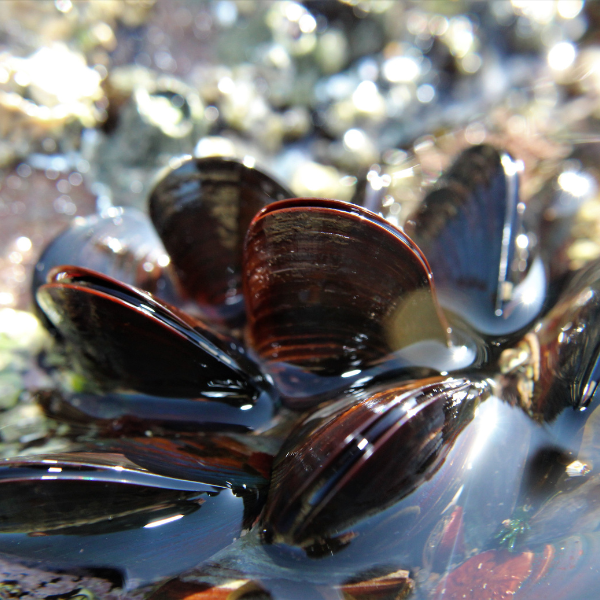
Mussel – Diúilicíní
Mussel is the common term used for members of several families of bivalve molluscs, from saltwater and freshwater habitats. These groups have in common a shell whose outline is elongated and asymmetrical compared with other edible clams, which are often more or less rounded or oval.
The word “mussel” is frequently used to mean the bivalves of the marine family Mytildae, most of which live on exposed shores in the intertidal zone, attached by means of their strong byssal threads (“beard”) to a firm substrate. A few species (in the genus Bathymodiolus) have colonised hydrothermal vents associated with deep ocean ridges.
In most marine mussels the shell is longer than it is wide, being wedge-shaped or asymmetrical. The external colour of the shell is often dark blue, blackish, or brown, while the interior is silvery and somewhat nacreous. The common name “mussel” is also used for many freshwater bivalves, including the freshwater pearl mussels.
Freshwater mussel species inhabit lakes, ponds, rivers, creeks, canals, and they are classified in a different subclass of bivalves, despite some very superficial similarities in appearance. Freshwater zebra mussels and their relatives in the family Dreissenidae are not related to previously mentioned groups, even though they resemble many Mytilus species in shape, and live attached to rocks and other hard surfaces in a similar manner, using a byssus. They are classified with the Heterodonta the taxonomic group which includes most of the bivalves commonly referred to as “clams”.
The mussel’s external shell is composed of two hinged halves or “valves”. The valves are joined together on the outside by a ligament, and are closed when necessary by strong internal muscles (anterior and posterior adductor muscles). Mussel shells carry out a variety of functions, including support for soft tissues, protection from predators and protection against desiccation.
The shell has three layers. In the pearly mussels there is an inner iridescent layer of nacre (mother-of-pearl) composed of calcium carbonate, which is continuously secreted by the mantle; the prismatic layer, a middle layer of chalky white crystals of calcium carbonate in a protein matrix; and the periostracum, an outer pigmented layer resembling a skin. The periostracum is composed of a protein called conchin, and its function is to protect the prismatic layer from abrasion and dissolution by acids (especially important in freshwater forms where the decay of leaf materials produces acids).
Both marine and freshwater mussels are filter feeders; they feed on plankton and other microscopic sea creatures which are free-floating in seawater. A mussel draws water in through its incurrent siphon. The water is then brought into the branchial chamber by the actions of the cilla located on the gills for ciliary-mucus feeding. The wastewater exits through the excurrent siphon. The labial palps finally funnel the food into the mouth, where digestion begins.
